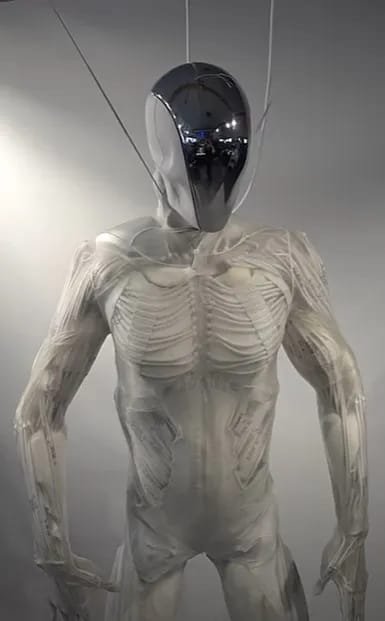
Protoclone: The World’s First “Synthetic Human” Unveiled by Clone Robotics
Wrocław, Poland / United States, April 2025 – In a groundbreaking development in humanoid robotics, Clone Robotics has unveiled Protoclone, a six-foot-tall android described as the world’s first “synthetic human.” With a body designed to closely mimic human anatomy—featuring artificial muscles, bones, and joints—Protoclone represents a major leap toward lifelike robotics.
The unveiling, showcased in a viral video on X (formerly Twitter), has stirred both awe and apprehension across social media, with the robot’s twitching movements and faceless black visor sparking a mix of admiration and unease.
Revolutionary Design
Clone Robotics, founded in 2021 in Wrocław, Poland, with operations in the U.S., has been working on musculoskeletal robotics for years. Protoclone is their most ambitious prototype to date, incorporating:
- A polymer skeleton with 206 synthetic bones,
- Over 1,000 artificial muscles built using “Myofiber” technology, which replicate muscle contraction by using hydraulic fluid,
- More than 500 sensors, including 4 depth cameras, 70 inertial measurement units (IMUs), and 320 pressure sensors,
- A 500-watt electric pump, circulating fluid at 40 liters per minute to power movement.
This anatomically accurate design gives Protoclone more than 200 degrees of freedom, allowing for lifelike gestures. However, it currently requires suspension from the ceiling to remain upright, and has not yet demonstrated the ability to walk independently.

Early Development Stage
Despite its sophisticated internal systems, Protoclone is still in the early stages of development. In the now-viral demonstration video, the robot is shown suspended, performing limited but human-like limb movements. The company aims for future versions of Protoclone to handle domestic tasks such as pouring drinks, preparing food, setting tables, doing laundry, and vacuuming.
Clone Robotics has not yet confirmed when the robot will achieve full mobility. However, it has announced plans to produce 279 units of “Clone Alpha” with pre-orders expected to open later in 2025. Pricing details remain undisclosed.
Public Reaction: Awe and Dread
Public response to Protoclone has been mixed. Some users described the robot as “awesome” and “revolutionary,” impressed by its detailed human mimicry. Others, however, found its faceless appearance and twitchy movements disturbing, likening it to a character from a sci-fi horror film. One comment read, “Can you just draw a smiley face on the head, please?” while another joked, “We had a good run, fellow humans.”
The stark contrast in reactions highlights society’s ambivalence toward human-like machines—seen by some as the future of household labor and by others as eerie imitations that challenge our comfort with technology.
The Road Ahead
Protoclone is part of Clone Robotics’ broader vision to create musculoskeletal, superintelligent androids with the dexterity to handle human tools. The company aims to eventually move from pneumatic to hydraulic actuation to enhance performance and balance.
Compared to other humanoid robots like Elon Musk’s Optimus and Boston Dynamics’ Atlas, Protoclone is praised for its anatomical realism. However, it still lags behind in mobility and stability, which are areas of active development.
Conclusion
As robotics continues to evolve, Protoclone stands as a compelling—if controversial—example of what’s possible. Whether it becomes a staple in future households or remains a prototype confined to labs will depend on further technological refinements and public acceptance.


